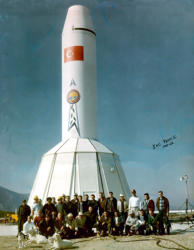
Jupiter SM-78 Weapon System
I&C Team 2, Çigli AB, Turkey 1961-1962 Chrysler Corporation Missile DivisionHISTORY - Page 27
believed the range capability for such a system would be about 1,300 nautical miles with a growth
potential to 1,400. Subsequently, the length was specified for 58 feet to assure the 1,500-mile range.
Plans were also becoming firm on developing other components of the missile. In the G&C section, the all-
inertial system appeared to offer the best approach, but there were some problems to be considered. To
achieve an accuracy of a 1,500-meter miss distance circular probable error (CEE) at full range, fuel cutoff
had to be effected within close limits. However, there were a number of these that could be resolved and
proven through testing. For the Navy, investigations were in progress to determine if the SINS could be
connected to the inertial guidance system. In any event, ABMA felt that a parallel program to develop
radio-inertial guidance was a must to assure that there was an adequate system when the missile was
operational. This could be accomplished through the coded Doppler radar command (CODQRAC) system, in
which considerable development progress had already been recorded.
The re-entry problem was being studied; too, and plans were made as to the methods of conducting tests.
ABMA was developing a three-stage vehicle with a detachable head that would approximate conditions of
the JUPITER upon re-entry. Twelve vehicles designated as composite re-entry test missiles (CRTM) were
allocated to this phase of the program. The REDSTONE and a cluster of scaled-down SERGEANT motors
served as the booster element.
______________________________









HISTORY - Page 27
believed the range capability for such a system would
be about 1,300 nautical miles with a growth potential
to 1,400. Subsequently, the length was specified for 58
feet to assure the 1,500-mile range.
Plans were also becoming firm on developing other
components of the missile. In the G&C section, the all-
inertial system appeared to offer the best approach,
but there were some problems to be considered. To
achieve an accuracy of a 1,500-meter miss distance
circular probable error (CEE) at full range, fuel cutoff
had to be effected within close limits. However, there
were a number of these that could be resolved and
proven through testing. For the Navy, investigations
were in progress to determine if the SINS could be
connected to the inertial guidance system. In any
event, ABMA felt that a parallel program to develop
radio-inertial guidance was a must to assure that
there was an adequate system when the missile was
operational. This could be accomplished through the
coded Doppler radar command (CODQRAC) system, in
which considerable development progress had already
been recorded.
The re-entry problem was being studied; too, and
plans were made as to the methods of conducting
tests. ABMA was developing a three-stage vehicle with
a detachable head that would approximate conditions
of the JUPITER upon re-entry. Twelve vehicles
designated as composite re-entry test missiles (CRTM)
were allocated to this phase of the program. The
REDSTONE and a cluster of scaled-down SERGEANT
motors served as the booster element.
______________________________





















